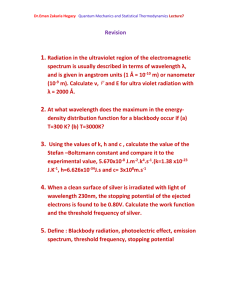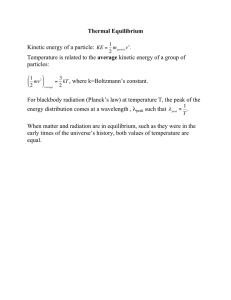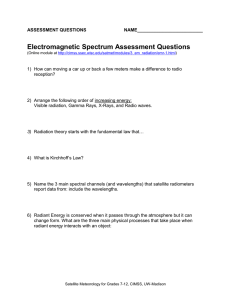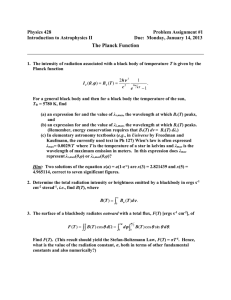Electromagnetic Radiation
advertisement
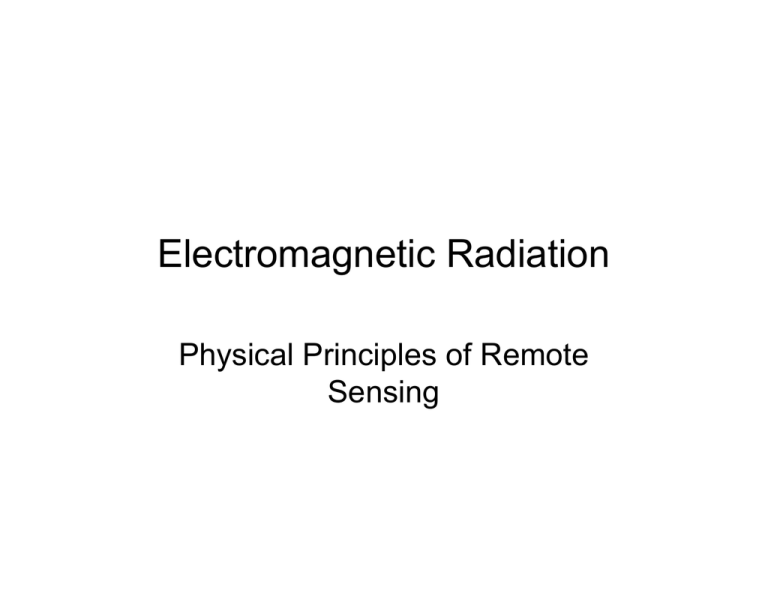
Electromagnetic Radiation Physical Principles of Remote Sensing Outline for 4/3/2003 • • • • Properties of electromagnetic radiation The electromagnetic spectrum Spectral emissivity Radiant temperature vs. kinematic temperature Energy Transfer • Energy is “the ability to do work” • Energy transfer: – Conduction: transfer of kinetic energy by contact between atoms or molecules – Convection: transfer of kinetic energy by physically moving the mass that contains the energy – Radiation: propagation via waves/particles through a vacuum (or through a medium) Electromagnetic Radiation • EMR is the source for most types of remote sensing – Sun and Earth are both passive sources of EM radiation – Lasers and radar are active sources • Generated by transformation of energy from other forms – – – – – Kinetic: thermal motion of atoms and molecules (heat) Electrical: radio frequency (dipole antenna) Magnetic: electron tube (microwave) Radioactive: decay of radioactive substances Chemical/Laser: molecular excitation Electrical (E) and magnetic field (B) are orthogonal to each other Direction of each field is perpendicular to the direction of wave propagation. Electromagnetic Waves Described by: • Wavelength • Amplitude Electromagnetic Radiation • Its harmonic wave form can be described according to the Maxwell equations: E x = E 0 cos(wt - kz) † Where, † E is the electric field w= angular frequency (2pn), n = c/l, l = wavelength c = speed of light in a vacuum (300,000 kms-1) k = wavenumber (2p/l) z = distance t = time Frequency vs. Wavelength The product of wavelength and frequency is a constant: n l=c l = distance of separation between two successive wave peaks n = number of wave peaks passing in a given time c = speed of light in a vacuum (300,000 kms-1) Energy vs. Frequency When considering the particle form of energy, we call it a photon The energy of a photon is proportional to frequency: Q=hn n = c/l Q = hc/l where, h = Planck’s constant = 6.626 10-34 Js Thus, Q ~ 1/l The EM Spectrum Polarization E and B fields are perpendicular to each other but their orientation can change • If both remain in their respective planes, the radiation is called “plane polarized” • If they rotate around the axis of propagation, the radiation is called “circularly polarized” or “elliptically polarized” • If their orientation changes randomly, it is called “randomly polarized” or unpolarized Polarization • Plane polarized light can be either – vertically polarized (E0 is perpendicular to the plane of incidence) – horizontally polarized (E0 is parallel to the plane of incidence) • Solar radiation is unpolarized (random) but can become polarized by reflection, scattering, etc. • Lasers and radars produce polarized radiation Spectral Emittance • All bodies whose temperature are above absolute zero Kelvin (-273.2 oC) emit radiation at all wavelengths • A “blackbody” is one that is a perfect absorber and perfect emitter (hypothetical, though Earth and Sun are close) • Planck’s Law describes how heat energy is transformed into radiant energy • This is the basic law for radiation measurements in all parts of the EM spectrum Planck’s Blackbody Equation Ml = † C1 l [e 5 C 2 lT -1] Ml = spectral radiant exitance (emittance), units are W m-2 mm-1 l = wavelength T = the blackbody’s temperature in Kelvin (K) C1 = 3.74151 ¥ 108 W m-2 mm4 C2 = 1.43879 ¥ 104 mm K Blackbody Radiation • According to Planck’s law, a blackbody will emit radiation in all wavelengths but not equally 4 • Stefan-Boltzmann Law: M = sT Emittance is proportional to physical temperature † s = 5.670 10-8 W m-2 K-4 • Graybody: M = esT 4 Object that reflects part of incident radiation e < 1.0 † Emissivity • Describes the actual absorption and emission properties of real objects (“graybodies”) • Is wavelength dependent • Emissivity = graybody emittance/blackbody emittance • Emissivity establishes the radiant temperature Trad of an object Radiant Temperature vs. Kinematic Temperature • Two objects can have the same kinematic temperature but different radiant temperatures Object Emissivity Kinematic Temperature Radiant Temperature Blackbody 1.0 300 300 Water, distilled 0.99 300 299.2 Basalt, rough 0.95 300 296.2 Basalt, smooth 0.92 300 293.8 Obsidian 0.86 300 288.9 Mirror 0.02 300 112.8 Wien’s Law lmax = a /T a = 2898 mm K • The wavelength of peak emittance is inversely proportional to the kinematic temperature • Sun’s temperature = 6000 K 2898/6000 = 0.48 mm • Earth’s temperature = 300 K 2898/300 = 9.6 mm Sun’s Radiant Energy Distribution Name of Spectral Region Wavelength Range, mm Percent of Total Energy Gamma and X-rays < 0.01 Negligible Far Ultraviolet 0.01 - 0.2 0.02 Middle Ultraviolet 0.2 - 0.3 1.95 Near Ultraviolet 0.3 - 0.4 5.32 Visible 0.4 - 0.7 43.5 Near Infrared 0.7 - 1.5 36.8 Middle Infrared 1.5 - 5.6 12.0 Thermal Infrared 5.6 - 1000 0.41 Microwave > 1000 Negligible Radio Waves > 1000 Negligible Emission spectrum of a 6000K blackbody leaving the surface of the sun SolarRadiation Emittance Curve Solar radiation at sea level • For terrestrial remote sensing, the most important source is the sun Reflected solar energy is used 0.3 - 2.5 mm • The Earth is also an energy source >6 mm for self-emitted energy
